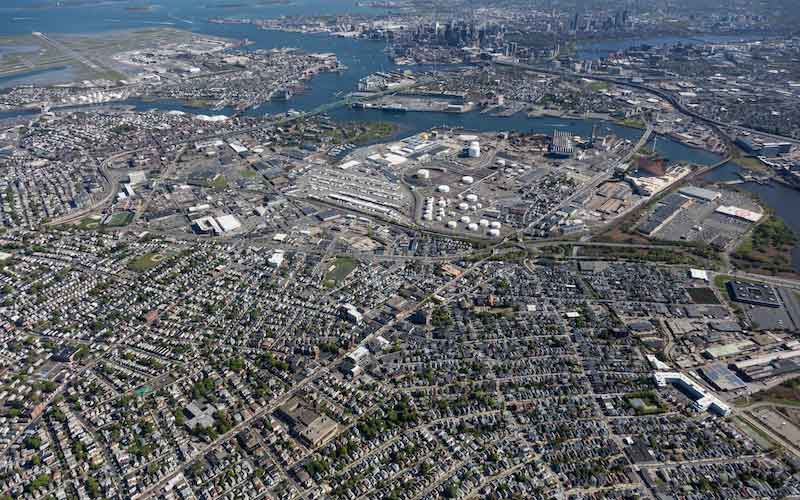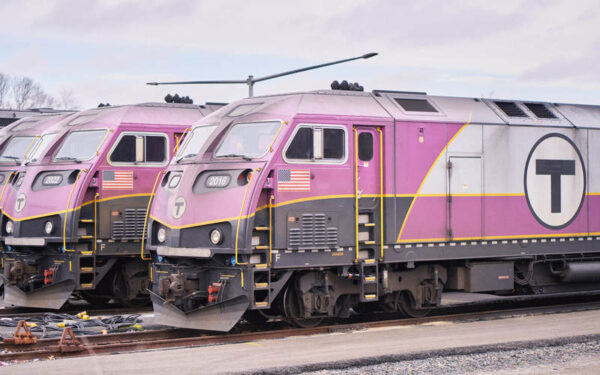
ExxonMobil's oil storage terminal in Everett, Massachusetts, sits on the Mystic River. Storm surge there would flood nearby neighborhoods with dangerous chemicals. Photo: Alex MacLean
We first published a version of this blog in September of 2017.
Over six days in August 2017, Hurricane Harvey dumped 27 trillion gallons of water on Houston and parts of the Gulf Coast, leaving a wide swath of destruction and toxic pollution for communities to deal with in the storm’s wake. Harvey damaged or destroyed 100,000 homes, and restoration efforts are estimated to have cost $190 billion.
Even as the floodwaters destroyed homes and businesses, they also inundated energy facilities owned by companies like ExxonMobil, Shell, and Chevron Phillips. Their inexcusable lack of preparedness for such floods placed the health and safety of millions of Texas residents at risk.
Then, just last month, Hurricane Laura slammed into the region again. Weather reports warned of its “unsurvivable storm surge,” projected to top 20 feet. So far, the federal government has received 31 reports of oil and chemical spills connected to the storm. A massive chemical plant in Westlake, Louisiana, caught fire, releasing chlorine gas into the air and forcing residents to shelter in place for more than a day. Federal agencies are still monitoring the situation, however, so the full extent of the damage – and danger – remains unknown.
Disturbing images of oil slicks and reports of cancer-causing chemicals released into the air and water should serve as an overdue wake-up call for the Big Oil giants, but not just for their Texas and Louisiana facilities. ExxonMobil, Shell, Gulf Oil, and Magellan all operate large oil storage facilities here in New England (an ExxonMobil facility sits on the Mystic River in Everett, Massachusetts, and a Shell terminal overlooks the Providence River in Rhode Island. Meanwhile, Shell, Gulf Oil, and Magellan have facilities on New Haven Harbor in Connecticut).
Just like their Gulf of Mexico counterparts, these facilities are poised to spew toxic chemicals into our waters and nearby neighborhoods if flooded by even a Category 1 storm (Hurricanes Harvey and Laura were Category 4 storms when they made landfall). Yet their Big Oil owners have failed to take necessary steps to fortify them against the climate impacts we know are coming. That’s why CLF is taking action to force these oil giants into action.
Big Oil Knows the Risks But Leaves Facilities Unprepared
While it’s too soon to understand the full fallout from Hurricane Laura, we can make some assumptions based on how Hurricane Harvey played out. In the wake of that storm, the Center for Biological Diversity reported that refineries and petrochemical plants released 1 million pounds of hazardous pollutants into the air, including benzene, hexane, hydrogen sulfide, sulfur dioxide, toluene, and xylene. They estimated that, overall, air pollutants released from all oil and gas facilities in the region totaled an astounding 5.46 million pounds. In one Houston neighborhood near a Valero Energy refinery, officials reported high levels of benzene, a known carcinogen. Concerns for residents there included short-term risks of dizziness, nausea, and lightheadedness, and, over the long term, increased risk of cancer.
In a 2015 blog, ExxonMobil forecasted what a storm like Harvey would mean for the region, writing, “… it only takes one storm to do major damage. A tropical storm or hurricane can destroy people’s lives and property. And its impact can incapacitate much of the energy production-and-supply infrastructure assembled along the Gulf of Mexico.”
Yet despite its own dire prediction two years in advance of Hurricane Harvey, ExxonMobil’s facilities were not prepared for the impacts of such a storm. From August 27 to September 2, ExxonMobil filed nine reports with the National Response Center regarding its facilities in Baytown, Beaumont, and Houston, most of which reported oil discharges and releases of toxic chemicals such as benzene, toluene, and xylene.
Lessons from the Gulf Must be Heeded Here at Home
The language ExxonMobil used to describe the risks facing its Gulf of Mexico facilities echoes how the company has described those facing communities surrounding its Everett oil terminal. In a letter to EPA attempting to justify why records related to its Everett terminal are too sensitive to be released publicly, ExxonMobil wrote, “Given the Terminal’s location, a security incident leading to a release at the Terminal would likely have catastrophic effects on both human life and the environment.”
Hurricanes Harvey and Laura made landfall as Category 4 storms. Storm surge from even a Category 1 storm would flood most of Exxon’s Everett facility. Many of the same chemicals released during Harvey are present at the Everett Terminal, including benzene, toluene, and xylene. However, despite acknowledging the “catastrophic” effects its Everett terminal would have on surrounding neighborhoods and the environment, ExxonMobil has failed to protect it against rising seas, increasingly intense rainfall, and storm surge.
Shell’s Providence Terminal is no more prepared than Exxon’s Everett facility to withstand rising seas, increasingly intense rainfall, and storm surge – even though its location, elevation, and lack of preventative infrastructure make it especially vulnerable to these risks. Local communities in and around Providence are directly in harm’s way. They have no assurance that they will be protected from pollutants released and discharged from the site into the Providence River, Narragansett Bay, and their communities.
In Connecticut, meanwhile, the entire Port of New Haven, where the Gulf Oil, Shell, and Magellan facilities are situated, sits on artificial fill. Combined with being located nearly at sea level, these facilities are at increasing risk from coastal flooding caused by sea level rise, increased rainfall, and bigger and more frequent storms. This isn’t just hypothetical. When Superstorm Sandy barreled through the region in 2012, it inundated the facilities. Only an unexpected change in the storm’s trajectory kept the flooding from being catastrophic. Yet eight years later, Gulf, Shell, and Magellan have still made no efforts to fortify their terminals against these known risks.
Legal Action to Hold Big Oil Accountable
According to the National Climate Assessment, “The intensity, frequency, and duration of North Atlantic hurricanes, as well as the frequency of the strongest (Category 4 and 5) hurricanes, have all increased since the early 1980s.” It is not a matter of if the next storm comes, but when. The impacts of Hurricanes Harvey and Laura were foreseeable. Yet, ExxonMobil and Shell left their facilities in Texas and Louisiana vulnerable – and now the surrounding communities are paying a terrible, long-term price. It is difficult to grapple with such a massive corporate failure. We can’t risk the same happening here in New England.
Conservation Law Foundation has filed a first-in-the-nation lawsuit against ExxonMobil for failing to harden its Everett Terminal against these impacts and endangering surrounding communities and the environment. We are also taking Shell to court over its Providence facility and, just last month, we put Shell, Gulf Oil, and Magellan on notice about their New Haven terminals.
The destruction wrought by Harvey and Laura – and these oil giants’ failures to live up to their responsibility to safeguard their neighbors from harm – can’t be dismissed. We will continue fighting to protect vulnerable communities and our environment from such corporate indifference and to hold Big Oil accountable for its actions.




